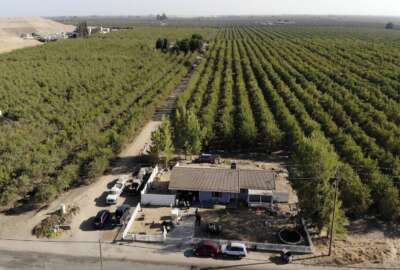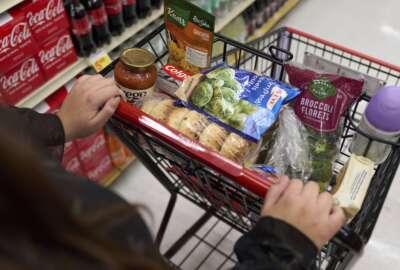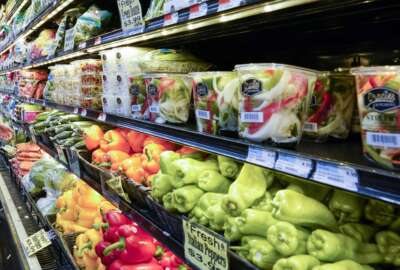Hubbard Radio Washington DC, LLC. All rights reserved. This website is not intended for users located within the European Economic Area.
These USDA employees modernized an old program so poor Americans could eat better
The Supplemental Nutrition Assistance Program (SNAP) is among the oldest enduring federal programs. Now, the Agriculture Department has found a way to help reci...
The Supplemental Nutrition Assistance Program (SNAP) is among the oldest enduring federal programs. Now, the Agriculture Department has found a way to help recipients eat well even if they live in what’s known as a food desert: no access to supermarkets or high quality food. Two finalists for Service to America Medals brought SNAP to online food buying. Federal Drive with Tom Temin spoke with the two Sammies finalists: Lisa Gafaldi, a Senior Technical Adviser to the SNAP program and Shelly Pierce, Director of the SNAP Policy and Innovation Division.
Interview Transcript:
Tom Temin All right. First of all, a little bit of background here. The SNAP program, traditionally people would go to a food retailer and exchange the benefits on that little card for properly vetted and the correct things they can buy under the SNAP program. How extensive are food deserts in the country as you define them, Shelly?
Shelly Pierce Sure. I don’t know that there’s a whole lot of hard data on that. I think that it varies a lot based on individual people’s circumstances. What we might not inherently think of as a food desert could very much be so for someone who lacks transportation or who perhaps works during the time when the stores around them do happen to be open. It varies, I think, with this population, based on what folks would normally think of as a typical food desert.
Tom Temin Sure. And so let’s get right to it to enable SNAP to get to online buying of food. And there’s no shortage of places there. And pretty much everybody has that access through a phone. Lisa, tell us what some of the technologies and technical approaches were required to even see if this was feasible.
Lisa Gafaldi Retailers needed to have a website, an e-commerce platform, as well as we needed to find a company that was able to provide a pin pad solution. Since at brick and mortar stores SNAP, recipients have to input a four digit pin in order to make a purchase. So we had to find a company to help us create and develop that and to integrate it into a retailer’s website as well as the state agencies. We needed their support in order to update their EBT systems in order to accept those transactions as well.
Tom Temin Yeah, and anyone who’s ever programed anything knows that that is not a trivial lift to get that pin system and so forth and end there. Was there any resistance from state programs that might have realized that the purchases with their dollars, state dollars would not necessarily go to in-state merchants anymore?
Shelly Pierce We actually have long had in the law that govern SNAP a requirement for SNAP benefits to be able to be used across state lines. So that’s something that they’re well used to. But I will say that early on, prior to the pandemic, there were several states that were maybe not as comfortable with the use of benefits online. And certainly nobody wants to be the guinea pig or first out of the gate. They kind of wanted to step back and let the others go first and see how it goes.
Tom Temin And what demand signals did you get from recipients and people using the SNAP program or from anybody else that this might be a good alternative? Because it seems really obvious in retrospect, but yet nobody thought of it till now.
Lisa Gafaldi At the beginning, I think that recipients were unsure. Obviously we were just getting into in general in the commercial world having e-commerce. So now to get groceries that was something relatively new. And then the pandemic hit, and that’s when it spread like wildfire. And everyone wanted to have that ability to shop online.
Tom Temin Right. Literally, the whole nation wanted to shop online at that point.
Lisa Gafaldi Yes.
Tom Temin And so what did it take? I mean, did you hire a contractor to do this? What were some of the steps? Give us a just a brief story of how you got four digit PIN capability into the cards, into the retailers online, because dealing with some of those companies is like dealing with the planet Mars. It’s very hard to find out who do you even call to ask about this capability?
Shelly Pierce Looking into the technology aspect of it is something that had been going on for several years. We certainly did. Most of the coordination on this, by and large, was handled by our team at FNS. So it was a very big task. And especially before the pandemic, we did run into several fits and starts with this because, as you said you’re working with many, many stakeholders, many large companies that have shifting and different priorities. Some of the partners we were working with had their companies sold or merged as we were working through. And then what had been a priority maybe wasn’t somebody else’s. So there was a lot of a lot of hand-holding and a lot of convincing and pulling some people along.
Tom Temin We’re speaking with Shelly Pierce. She’s director of the Policy and Innovation Division of the Agriculture Department’s SNAP program. And Lisa Gafaldi, a senior technical adviser there. So who were the first guinea pigs that said, okay, we’ll put a four digit PIN on our site, etc.?
Lisa Gafaldi Just to provide some background, in 2017, we published a request for volunteers and that was directed towards retailers. So a bunch of retailers provided proposals and we selected Amazon, Walmart, Shoprite, Wakefern and Wright’s Supermarket located in Alabama. So obviously you have the bigger companies Amazon, Walmart, and then you have some medium sized supermarkets, which is Wakefern, and then you have a small retailer which is Wright’s located in Alabama. So that was going through. And then at the same time we had to sort of beg states to volunteer themselves. So New York was the first state to raise their hand and support this initiative. At that point, we worked with their EBT host processor as well as a company who provided the pin pad and it was probably a two year process to get this up and running. And in April of 2019, we process the first transactions with Amazon, Walmart and Shoprite and Wright’s came on a few months later.
Tom Temin And how is it working? What’s the take up? Give us a sense of the metrics here to know that this is a program that’s being accepted.
Shelly Pierce So after the first five or so initial states went online, they stood up around early April was the last one of 2020. So then, of course COVID hit and we expanded to an additional 40 plus states by that fall, as well as adding many additional retailers. Right now, we have about 4 million households that shop online nationwide each month and those households may make multiple purchases. We have a little over 200 retailer banners, as we call them. I mean, for context, Walmart would be one of those. And that we have about 9% of the overall SNAP benefits that are redeemed each month are redeemed online. So that makes them our third highest redeeming type of store behind supermarkets and superstores.
Tom Temin Interesting. So it really wasn’t necessarily a great loss for the local mom and pop type of store or the highs or the these kinds of or some of them are still independently owned. It sounds like most of the business anyway, was to the larger end of the retail chain.
Shelly Pierce They typically did redeem more in benefits. But I will say a lot of the retailers that we’ve brought on, especially over the last year or so, are what you would consider as smaller retailers like many single owned operations and one or two stores and things like that.
Tom Temin And just a technical question, Lisa, besides the PIN, which was a technical capability, it’s like establishing the 988 number nationwide. Easy to say. It takes years of work to do. Of course, the rules that go with the redeeming of SNAP benefits, you can’t buy beer and cigarettes, etc., etc. How does that get programed in? That must have been quite a challenge to make sure that only the proper items could get through the system that way.
Lisa Gafaldi Yeah, there’s some rules that are requirements that the retailers had to implement on their websites and it was a little bit difficult at first because we were working with the really techie people who didn’t understand the requirements behind SNAP because they didn’t work in that area in the brick and mortar world, they were just setting up a website. So one of the rules obviously is that SNAP recipients can only purchase SNAP eligible foods. And what we had to do is do a lot of testing. The retailers had to provide us with business requirement documents that laid out how they were going to implement all of those requirements that we establish in the request for volunteers. And then they did their their website build. And then when they were ready to have us look at it, we did intensive testing and then they were able to go live at that point.
Tom Temin And does a SNAP card, by the way, work like a debit card, once it’s empty, it’s empty. And then the number will show this banking system that it’s out of money?
Lisa Gafaldi Correct. And so that was the other thing, too. We had to ensure that the transaction response codes made sense to the recipients because in the credit and debit world, if your card doesn’t work usually the response is go talk to your bank. We don’t have a bank here. So we had to ensure that those responses made sense. If they had insufficient funds, if they had a bad PIN and things like that.
Tom Temin And so where do we go from here? Now that you’ve got this really good base of operation, millions of people using it, millions of dollars, I guess even 9% of SNAP is a lot of money. What’s next for the program?
Shelly Pierce Well, in terms of online we continue to look for ways to help some of the smaller retailers in more rural areas move towards being able to update their websites. If they’re able to support whether it’s delivery or pickup. We’re also kind of looking to the what’s next of the programs that we’ve just started, that early stages of implementing pilots for mobile payments. So where you could add your SNAP card to your mobile wallet and use it in store that way.
Copyright © 2024 Federal News Network. All rights reserved. This website is not intended for users located within the European Economic Area.
Tom Temin
Tom Temin is host of the Federal Drive and has been providing insight on federal technology and management issues for more than 30 years.
Follow @tteminWFED
Related Stories
What exactly is organic food? USDA wants to make sure everyone follows the rules
Related Stories
-
USDA modernizes an important research facility with a whole new building Facilities/Construction





